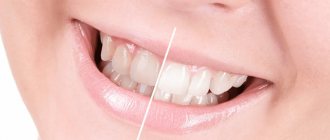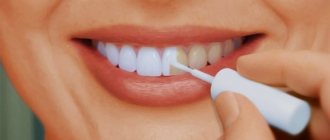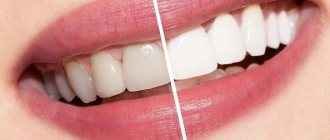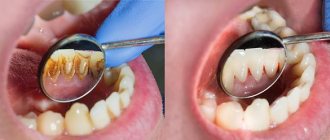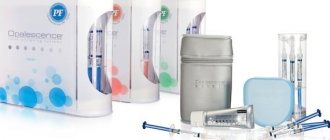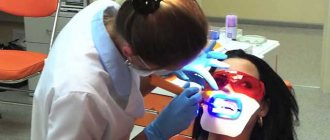Indications Is bleaching harmful?
Why do teeth darken? Whitening methods Safety of home whitening Whitening in dentistry Stages Care A snow-white smile is the dream of every person. And everyone is interested in safe teeth whitening. Many people have heard about bad experiences from friends and the Internet and are afraid to repeat these mistakes. But the procedure has been well studied, but it is important to know which Moscow clinic can provide truly high-quality and gentle teeth whitening.
Is whitening safe?
What is teeth whitening? This is a cosmetic procedure in which the color of dentin changes (namely, the color of the tooth depends on it) - lightening by several tones under the influence of active substances. Whether it is safe or not depends on the professionalism of the dentist, as well as on the technologies and drugs that are used for these purposes (these must be registered drugs, modern methods). If we are talking about whitening at home, everything is the same, only instead of a doctor, it is the rationality of a person.
ROOTT Clinic expert on the most important things when whitening
In general, whitening is a fairly safe procedure if the teeth have good mineralized enamel, healthy gums and good oral hygiene.
Professional whitening of pulpless teeth
Whitening a dead tooth in a dental office is a completely safe and most effective procedure. One of the popular methods of professional lightening is endobleaching. The procedure is carried out in the following order:
- First, the dentist removes the old filling from the pulped tooth;
- then a special bleaching agent is introduced into its internal cavity. In most cases this is sodium perbonate, if necessary a small amount of hydrogen peroxide is added to it;
- After this, the doctor installs a temporary filling. If it is necessary to re-inject the brightening reagent, the filling is removed again. The number of procedures depends on the degree of darkening of the tooth;
- Once the desired color is achieved, a permanent filling is placed on the tooth.
In addition to intracanal bleaching, the dentist may also suggest other methods, for example, the use of veneers or crowns.
Indications and contraindications
Most often, the patient prescribes the indication for whitening to himself - he is not satisfied with the aesthetic appearance of especially the front teeth, which are visible when smiling. I want it to be whiter and more dazzling.
Darkening of the enamel can also occur due to frequent intake of coffee, cigarettes, dark berries and even medications.
But there are also a number of contraindications
:
- pregnancy and lactation;
- age under 18 years;
- allergies to drugs;
- the presence of fillings, crowns, veneers (they simply do not whiten);
- bracket systems, staples;
- cancer;
- hypersensitivity;
- active caries, periodontitis or other oral diseases;
- wedge-shaped defect (dentin exposed);
- rapid abrasion of enamel;
- in some cases diabetes mellitus.
You should definitely consult with your doctor about indications and contraindications so that together you can choose a safe method for teeth whitening. And of course, carry out a complete sanitation of the oral cavity to avoid uneven color after the procedure.
Before-after photos of teeth whitening at the ROOTT clinic
A typical problem is darkening of the front tooth
When a patient sits in the dental chair with a complaint of tooth darkening, the doctor first finds out the cause of the discoloration. As a rule, the patient claims that the tooth has already survived caries treatment. What could cause the color change?
- Formalin, used in previous years, gives the filled tooth a pink tint, and “silver” fillings cause it to darken.
- The enamel also darkens during pulpitis or periodontitis, when pulp necrosis occurs.
- Teeth acquire a dark shade when traumatized, accompanied by the formation of so-called tertiary dentin (calcification), when treating caries with leaky fillings or when using intensely colored pastes.
- Discoloration is observed in patients who abuse smoking and colored drinks (strong coffee, tea, etc.).
The most effective method of restoring color in such cases is intracanal teeth whitening.
If the darkening was caused by poor-quality root canal treatment, during which certain organic substances were left in the tooth cavity, whitening may not be enough.
- First, the dentist will have to unfill the canals and re-treat them under a microscope, as a result of which the tooth will become lighter.
- Then carry out internal whitening and perform artistic restoration of the tooth using high-tech materials or ceramic veneers, which have the transparency of natural tooth enamel.
What harm can bleaching cause?
The safest teeth whitening will be under the supervision of a professional dentist. Indeed, with inept management and the wrong approach, a number of troubles can arise:
- Negative effects on tooth enamel of incorrectly selected concentrations of bleaching agents. This is both increased sensitivity and an increase in the microporosity of its structure. Over time, the ingestion and accumulation of food dyes may cause the tooth color to become even darker than before;
- chemical burn of gum tissue due to improper isolation;
- uneven lighting.
Why doesn't classic whitening help?
Teeth whitening from the enamel side, which is popular in Moscow, will be ineffective, since the problem lies in the darkening of the internal tissues. They are the ones that shine through the tooth enamel that has retained its shade. External influence will not have any effect on the darkened hard tissue, so the intervention should be carried out specifically in the tooth cavity.
Conservative, simple and affordable internal tooth whitening allows you to preserve the tissues of the crown and root parts of the tooth and provides the desired aesthetic effect.
What whitening methods are there?
The dentist will advise which teeth whitening is safe for each patient individually. But everything that takes place under the supervision of a doctor will definitely not harm - there is no doubt about it, especially when using the latest technologies, delicate compounds and modern developments.
Professional teeth whitening methods:
- Photobleaching;
- laser whitening;
- whitening gel only;
- hardware method.
The first two methods use a lamp or laser as a catalyst for the action of the whitening gel.
Photobleaching, for example, ZOOM, enhances the effect of active hydrogen peroxide, helping to quickly break it down into free radicals - oxygen atoms. of up to 10 tones occurs.
. With proper care, the results last for several years.
The laser procedure differs in that instead of a light beam, a laser beam acts. It can heat the surface, which causes sensitivity (everything is in the hands of a professional doctor, since the advantage of a laser is accuracy), and copes well with changing color by 10-12 tones
and maintaining it for up to 5 years. The downside is the high cost of the method.
Dentists are still arguing about what is the safest teeth whitening, and whether laser and light are necessary for the best results. But it has been proven that the method of applying gel without using them is also effective. Opalescence technology with 40% hydrogen peroxide in the gel is cheaper in price and has proven itself in aesthetic dentistry.
A simple dental cleaning at the clinic is often sufficient for many people. After removing stones and plaque, the teeth become several shades lighter. Using one of these methods:
- Air-Flow hardware cleaning (the principle is similar to a sandblasting machine, but instead of sand, soda);
- ultrasound.
You can be satisfied with the result of your renewed smile.
Where can I have teeth whitening with fillings done at a low price?
Why should you contact the TriDental dental clinic? – the answer is simple, here are our advantages:
- a free examination is carried out before treatment;
- painlessness of all procedures due to high-quality anesthesia;
- for regular patients special conditions for cooperation;
- promotions and discounts will be a pleasant surprise for everyone;
- Several technologies are offered for whitening teeth with fillings;
- All services are guaranteed!
For any questions, you can always contact our managers for advice.
Is it possible to whiten teeth safely at home?
The market offers more and more varieties of home whitening methods, whether they are safe or not - everything is individual. And the course usually lasts 10-20 days. However, not everyone is of any use.
Manufacturers offer:
- Whitening strips;
- mouth guards with active composition;
- felt-tip pens, markers;
- toothpastes with whitening effect.
All products contain the same hydrogen peroxide, but in a much lower concentration. Therefore, it will be possible to lighten and visually change the color of the enamel by 1-2 tones.
Rather, this is a lightening procedure, that is, you can safely bleach if you agree to change the shade by just a couple of tones, and are willing to spend a lot of time for a relatively small result.
But using professional products at home is not recommended. Is it dangerous.
Methods for whitening at home
Those who want to get themselves in order without leaving home can also easily find a decent option for themselves. The main thing is accuracy and moderation. And we discussed this issue in more detail in the material “Home teeth whitening - TOP 10 methods.”
Whitening toothpastes
Such products really help get rid of the notorious plaque and lighten the tones somewhat. However, their use is fraught with the appearance of micro-scratches. To achieve a noticeable effect, you will need to regularly use a suitable preparation, the continuous use of which increases the risk of damaging the enamel. You can buy cross brand toothpaste from the USA in this section.
Table soda
An effective, safer, but still merciless way to whiten your teeth at home. In this case, the color will not change, but the soda used as an abrasive will certainly clean the teeth that have been rubbed with it from plaque and will certainly damage the protective shell.
Hydrogen peroxide
Depending on the concentrate of the substance and the duration of its use, it can make the smile snow-white: the longer the product is not washed off, the whiter the teeth become. One main fact that should not be overlooked is that frequent use of hydrogen peroxide as a whitening agent can cause gingivitis or periodontitis. Therefore, in order to avoid damage to the gums and increased sensitivity, you should not abuse the drug.
Wood ash
Potassium hydroxide contained in the ash has bleaching properties. After applying, leaving for some time and rubbing the teeth with the substance, the result will be visible, but the effect will be extremely short-lived. And frequent use of the method, in turn, has an extremely negative effect on the enamel.
Mouthguards
One of the safest and most effective methods requires third-party intervention from a specialist - you will need to make an individual mouthguard based on dental impressions. To whiten using this method, you will need a special gel and a tray itself. It is enough to apply the gel, put on the nylon product, wait and your smile will shine white.
Whitening strips
A new product that has caused a real sensation in the field of dentistry. Having gathered together the accumulated knowledge and best practices, the world-famous leader in the production of hygiene products has found the optimal solution to the pressing problem. Created by true professionals, the Crest 3D White Whitestrips system for home teeth whitening has created a method that satisfies all needs. Elastic strips that follow the shape of your teeth when “glued” are already covered with an optimal amount of gel that is safe for enamel and gums. All you have to do is stick the strip on, wait and get real 3D whitening that makes your smile truly brilliant and natural.
In addition, today Crest 3D White Whitestrips is perhaps the only product that does not harm the enamel, even when using several strips one after another. The effect is guaranteed to last for at least 12 months, which is simply impossible when using other methods of teeth whitening at home.
Safe whitening steps
- It is necessary
to carry out professional oral hygiene a few days - Isolation of soft
gum tissue. If you isolate the gum incorrectly, the patient will receive a severe burn, which will lead to complications. Therefore, safe teeth whitening in dentistry should only be carried out by an experienced doctor specializing in this field. - A special gel
based on hydrogen peroxide is applied. It is updated every 15 minutes: it is removed from the surface of the teeth (as it develops its properties) and a new portion is applied. The gel is changed three times. - Activation of the gel using a special lamp
. The dentist places a special lamp, the light of which will activate the gel. It is necessary to speed up the procedure and reduce it to 1 hour. The lamp has a cold LED light that does not heat the enamel structure and the procedure is comfortable for the patient. - Removing gel
from the enamel surface and all insulating materials from the gum surface. - Procedure for strengthening teeth
. A gel is applied that strengthens tooth enamel and reduces sensitivity.
Whitening is carried out in the smile zone, from 5 to 5 teeth of the lower and upper jaw. The procedure takes on average 1 hour
. Anesthesia is not given. This is necessary so that there is direct contact between the patient and the doctor, and the former can report if discomfort or pain occurs. Otherwise, you may miss the moment when something went wrong: a burn to the mucous membrane, too aggressive exposure to the material, a person’s low pain threshold.
Causes and consequences of darkening of tooth enamel
Discoloration is a fairly common phenomenon. Its detection is a direct signal notifying that you are in danger. As a rule, the cause of plaque and darkening is:
- Failure to comply with hygiene rules, resulting in the accumulation and compaction of plaque from food debris and bacteria;
- Smoking. The resinous substances contained in the smoke first change the tone, and later completely turn the smoker’s teeth dark brown;
- Abuse of wines and bright juices, herbal tinctures, black tea, coffee. Natural and synthetic food dyes eat into enamel quite easily;
- Sweets. The consequence of excessive consumption of sweets can be a carious process that changes the optical density and color of the affected tooth;
- Excess fluoride. Drinking drinking water with a high content of this chemical element can cause not only aesthetic discomfort, but also endemic fluorosis - a rather serious disease;
- Poor quality treatment. Some substances included in outdated filling materials significantly change color after procedures;
- Injury. Damage to the neurovascular bundle instantly changes the shade, and the consequence of tissue breakdown will inevitably be complete darkening;
- Antibiotics and medications. Taking certain medications by pregnant women contributes to the accumulation of harmful substances in the developing buds of the fetal teeth, which threatens the unborn child with an unpleasant enamel color;
- Diseases and hereditary diseases. Unfortunately, in such cases, teeth whitening is not effective; therapeutic or orthopedic treatment will be required;
- Age-related changes. Aging of fabrics changes not only the shape and structure, but also the color.
It is necessary to realize that darkening of the enamel, regardless of the cause, will inevitably lead to more serious problems. Pathogenic bacteria thrive in plaque, where a favorable environment is created for the destruction of diseases that contribute to destruction. Often, darkening is followed by caries and the loss of one or more teeth.
Veneers as one of the options for solving the problem
Returning to the question of how to whiten metal-ceramic teeth, it must be repeated that the paints and varnishes existing on the market today cannot ensure long-lasting results, so patients have to look for other alternative solutions to the problem. For example, you can install veneers - thin snow-white overlays that are fixed on the front surface of the teeth using a special adhesive composition, thereby masking any minor defects, including chips, pigmentation, slight curvature and crevices.
Veneers can help change the color of teeth
Modern veneers are created from durable ceramics or glass ceramics, which are quite resistant to mechanical stress and are not subject to staining. However, before installing them, the teeth have to be ground down, and they will not return to their original state.
“I had a large filling on my front tooth since my youth, when I was involved in professional sports. Naturally, over time it became gray, and this was very noticeable. At some point I simply stopped smiling and complexes appeared. That's why I decided to get veneers. The doctor recommended E.max, it is glass ceramic, it looks beautiful and natural. It’s already been three years since I installed it, nothing has chipped anywhere, as they scared me. So I'm very pleased."
Nika11.91, from correspondence on the forum www.32top.ru
Therefore, an even better option is Lumineers. These are very thin and at the same time durable plates, the installation of which does not require preliminary preparation of the enamel. In both cases, it is first necessary to take impressions of the patient’s teeth, and microprostheses will be created based on them. There is also the option of installing veneers using the direct method - in this case, the doctor will cover the teeth with a layer of composite. However, there are some nuances here. For example, the material can also fade over time and is typically inferior in strength and durability to veneers created from impressions in a laboratory.
Is it possible to whiten metal-ceramic crowns?
Unfortunately, it is impossible to achieve perfect whitening of fillings and metal-ceramic crowns. So, for example, modern dental ceramics is a fairly dense and hard material, so the brightening compounds used today have practically no effect on it.
The photo shows a metal-ceramic crown
But if the restored areas and prosthetic structures are located in the posterior parts of the jaw, the front teeth can be whitened. Then the difference in shades will not be noticeable. Otherwise, it will not be possible to achieve uniform whitening and an aesthetically pleasing smile. To do this, you will have to look for other solutions to the problem.
Is it possible to clean teeth with caries with ultrasound?
The use of special hygiene products helps to curb the development of caries. But this measure is effective only with a superficial process affecting individual teeth. A fluorine-containing composition, which is applied to the enamel after ultrasonic cleaning, helps increase the resistance of tissues and restore their anatomical structure. For additional protection, fissures are sealed.
But in case of multiple or deep caries, neither ultrasonic cleaning, nor even mechanical cleaning is recommended. The affected enamel is very sensitive, so treatment will cause significant pain and aggravate caries if deep tissues are affected.
Why is it better to do whitening after filling, but before prosthetics?
If you want to undergo a whitening procedure, but also have a filling, you still need to take care of your dental health first. For example, professional in-office whitening is carried out only after removing plaque and deposits, installing fillings or replacing them. You should immediately discuss your plans with your doctor and select the material of the desired shade.
As for prosthetics with crowns, this procedure can be carried out after bleaching. This will make it easier to choose a ceramic shade that exactly matches the current enamel color.
Type and size matters
The answer to the question whether it is possible to whiten filled teeth largely depends on the type of material:
- cement - the cheapest and very fragile type;
- photopolymer - high-quality material, contains phosphorus;
- metal – used to restore chewing teeth;
- glass ionomer cement – used to prevent caries.
Each type has the ability to whiten, but low-quality material does not lighten as well, so dentists do not recommend using it.
Bleach interacts best with a photopolymer or light filling.
The procedure does not give a permanent result; the enamel remains white for a long time, but there is no filling; after a while the manipulation will have to be repeated.
Whether fillings are whitened during regular teeth whitening also depends on the size of the filled area. Small areas are easily bleached; after a while, such fillings can be covered on top with a new, beautiful layer (the main thing is to accurately select the original shade) or the material can be completely replaced. It's not very expensive and doesn't last long.
With large areas it is more difficult. After a whitening session, the filling areas become stained, and the same problem occurs with the front teeth.
In this case, it is better to use ceramic veneers or crowns.
How to deal with depulpation
Depulpation is the removal of the nerve from the dental body.
When the pulp and nerve are removed, the tooth dies and eventually turns black inside. Pulpless teeth are yellowish. In this case, regular lightening will not bring results.
Intracanal manipulation has been developed for pulpless teeth. The essence is this: the root canal is filled, then a gel solution is injected, which brightens the dark places, and a crown is applied on top. The patient chooses the color of the crown himself.
Principles of caring for metal-ceramic crowns
To prevent darkening of fillings and crowns, it is important to provide competent and systematic oral care. As mentioned above, basic hygiene rules include regular brushing of teeth twice in the morning and evening, rinsing after each meal, as well as visiting the dentist for prevention and cleaning of dental plaque at least once every six months.
If you have a bridge in your mouth with metal-ceramic crowns, it is important not to forget to clean the rinsing channel located between the gum and the structure. An irrigator is ideal for these purposes. Experts in the field of prosthetics also provide the following recommendations regarding the care of metal ceramics:
- try to avoid temperature changes in food and drinks, due to which the porosity of the material increases and it turns yellow,
- If possible, avoid coffee and strong black tea, since these drinks quickly lead to staining,
- You should not gnaw hard foods with your teeth or crack the shells of nuts and seeds.
An irrigator is an additional device for maintaining oral hygiene.
To keep your teeth healthy and your smile snow-white, you need to pay enough attention to caring for and maintaining hygiene. Modern fillings are made from high-quality materials that cannot be stained for a long time. The same can be said about modern dental ceramics, which are distinguished by their durability, high aesthetics and color fastness. Therefore, with proper care, the material will not darken and will retain its aesthetic properties throughout its entire service life.
1According to data at the office. manufacturer's website: dentalpaint.ru.

